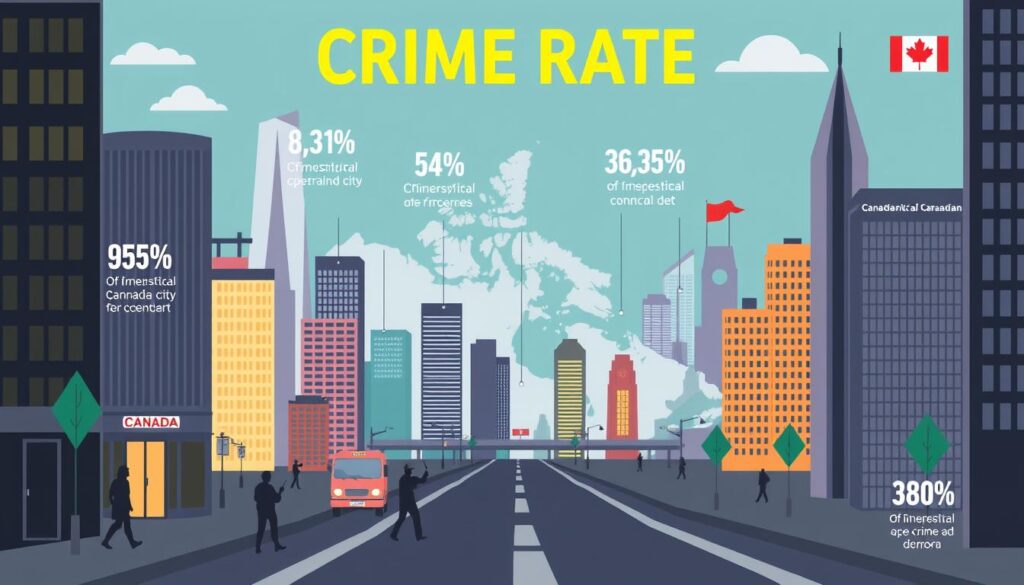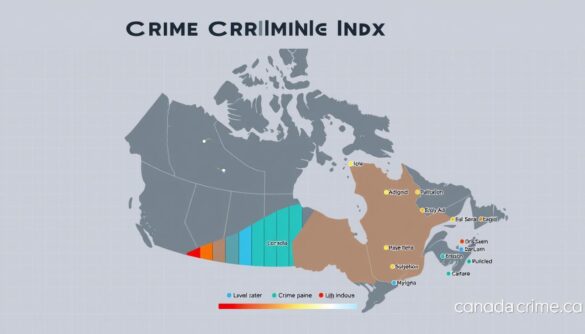Canada, ranked as the 11th safest country out of 163 nations, has seen a concerning trend in its crime statistics. Despite its global standing, the Crime Severity Index (CSI) rose by 2% in 2023, marking the third consecutive year of increase. This shift highlights the varying crime rates across different cities and regions within the country.
The CSI measures both the volume and seriousness of offenses, providing a comprehensive view of public safety. Understanding these patterns is crucial for residents and visitors alike. As crime rates continue to fluctuate, examining the types of criminal activity and regional differences becomes essential.
This analysis will explore the current crime landscape, identifying the safest and most dangerous cities, and discussing effective prevention strategies.
Understanding Crime Statistics in Canada
Understanding the nuances of crime statistics is vital for assessing public safety in Canada. Crime statistics serve as a foundational element in evaluating the effectiveness of law enforcement and criminal justice policies. The Canadian constitution vests the power to establish criminal law and rules of investigation in the federal Parliament, while provinces share responsibility for law enforcement.
The collection and analysis of crime data are critical for informed decision-making. Statistics Canada plays a pivotal role in this process, working closely with law enforcement agencies to compile and analyze crime statistics.
The Crime Severity Index Explained
The Crime Severity Index (CSI) is a sophisticated measure that reflects the volume and severity of crime in Canada. It takes into account the relative seriousness of different crimes, providing a more nuanced understanding of crime trends. The CSI is calculated based on the number of crimes reported to the police, weighted by their seriousness.

How Crime Data is Collected and Reported
Crime data collection in Canada follows a standardized process through the Uniform Crime Reporting (UCR) Survey. This survey gathers detailed information from police services across the country, ensuring consistency in reporting. The UCR Survey captures information on all Criminal Code offenses and federal statute violations, including the nature of the incident, characteristics of victims and accused persons, and case outcomes within the justice system.
Key aspects of crime data collection include:
- The role of Statistics Canada in compiling and analyzing crime statistics.
- The importance of population figures in calculating crime rates per 100,000 population.
- The evolution of data collection methods, including the implementation of the UCR2 Survey.
- Limitations in crime data collection, such as unreported crimes and inconsistencies in reporting practices.
Current Canadian Cities Crime Rate Overview

Crime statistics in Canada reveal significant differences between urban and rural areas. The country’s crime landscape is influenced by various factors, including population density, socioeconomic conditions, and access to police services.
The crime rate in Canadian cities is a complex issue, with different types of criminal activity prevalent in metropolitan centers compared to rural areas. Understanding these differences is crucial for developing effective crime prevention strategies.
National Crime Trends (2022-2025)
Recent national crime trends in Canada have shown varying patterns across different regions. From 2022 to 2025, crime rates have fluctuated, with some areas experiencing increases in violent crime while others have seen decreases in property crime.
Data from Statistics Canada indicates that the Crime Severity Index (CSI) has been a valuable tool in understanding these trends. The CSI measures both the volume and severity of crime, providing a more comprehensive picture than raw crime rates alone.
Notably, the eastern provinces generally have lower violent crime rates compared to the western provinces and territories. Manitoba and Saskatchewan have among the highest violent crime rates among the provinces, while the territories often experience rates significantly higher than the national average.
Urban vs. Rural Crime Patterns
Urban and rural areas in Canada display distinct crime patterns. Metropolitan centers typically experience higher overall crime rates but different types of criminal activity compared to their rural counterparts.
Population density plays a significant role in these differences. Urban areas face challenges related to property crimes, gang activity, and drug trafficking. In contrast, rural communities often struggle with issues like domestic violence, impaired driving, and longer emergency response times.
According to Statistics Canada, rural areas, particularly those in the Prairie provinces and territories, often experience higher rates of violent crime per capita. This contradicts the common perception that cities are inherently more dangerous.
The Crime Severity Index highlights notable disparities between urban and rural settings. Some remote communities in the territories record CSI values up to ten times the national average due to complex socioeconomic factors and limited resources.
Access to police services varies significantly between urban and rural settings. Urban areas have approximately one police officer per 500 residents, compared to much lower ratios in remote communities, affecting response times and crime prevention capabilities.
Indigenous communities, particularly those in rural and remote locations, face disproportionately high crime rates due to historical factors, systemic issues, and socioeconomic challenges. These communities require specialized approaches to community safety.
Top 10 Cities with Highest Crime Rates in Canada
The crime landscape across Canadian cities is diverse, with certain urban centers grappling with higher crime rates. Understanding which cities are most affected can provide insights into the underlying causes of crime and potential solutions. This section will explore the top 10 cities with the highest crime rates in Canada, dividing them into Western and Eastern Canadian cities.
Western Canadian Cities
Western Canada, known for its vast landscapes and urban centers, experiences its share of crime. Cities like Vancouver and Calgary have seen fluctuations in crime rates over the years. While specific crime statistics for Western Canadian cities are not detailed here, it’s essential to recognize that urban areas tend to have higher crime rates compared to rural areas. Factors such as population density, economic conditions, and policing strategies play a significant role in shaping crime trends in these regions.

Some Western Canadian cities have implemented community-based initiatives to combat crime. For instance, neighborhood watch programs and community policing have been effective in reducing crime rates in certain areas. However, the challenge persists, and continued efforts are needed to address the root causes of crime.
Eastern Canadian Cities
Eastern Canadian cities, particularly those in Ontario, have been grappling with concerning crime rates. Cities like Greater Sudbury, Sault Ste. Marie, Hamilton, Brampton, and London have experienced significant challenges. According to the data, Greater Sudbury ranks highest among these cities with a Crime Index of 61.9 and a Safety Index of 38.1, facing particular challenges with violent crime rates.
- Greater Sudbury has a Crime Index of 61.9, with violent crime rates almost double those of non-violent offenses.
- Sault Ste. Marie follows closely with a Crime Index of 60.2, struggling with drug-related offenses.
- Hamilton has seen its Crime Index rise to 55.8, with persistent issues related to break-ins and vehicle theft.
- Brampton has emerged as a concerning area with a Crime Index of 55.3, facing safety challenges related to rapid growth and urban expansion.
- London, Ontario, rounds out the top eastern cities with a Crime Index of 53.9, experiencing growing concerns particularly with property and drug-related crimes.
These cities are not only struggling with crime but are also working towards implementing effective crime prevention strategies. Community-based programs and collaborative efforts between law enforcement and local organizations are crucial in addressing the complex issue of crime in these areas.
Safest Canadian Cities and Their Characteristics
The safest cities in Canada share distinct characteristics that contribute to their low crime rates. These cities not only provide a secure environment for their residents but also serve as models for other communities striving to reduce crime.
Quebec City and Other Low-Crime Areas
Quebec City is often cited as one of the safest cities in Canada, boasting a low crime rate and a high safety index. Other cities like Oakville and Burlington also demonstrate low crime rates, attributed to their strong community engagement and effective policing strategies. These cities exemplify how a combination of social cohesion, economic stability, and well-designed urban environments can lead to safer communities.

Common Factors in Low-Crime Communities
Communities with consistently low crime rates across Canada share several common characteristics. These include strong social cohesion, economic stability, and effective urban design. Economic factors play a significant role, with low-crime communities typically featuring lower unemployment rates and reduced income inequality. Urban planning elements such as well-lit streets and mixed-use developments also contribute to safety by deterring criminal activity. Furthermore, effective law enforcement strategies that emphasize community policing and problem-oriented approaches are crucial in maintaining low crime rates.
Additionally, educational attainment and opportunities correlate strongly with lower crime rates. Communities with higher graduation rates and accessible continuing education programs tend to experience fewer incidents of both violent crime and property crime. Social programs focusing on youth engagement, mental health services, and family support also create protective factors that help prevent crime before it occurs.
Types of Crime Prevalent in Canadian Urban Centers
Canadian urban centers experience a diverse range of crimes, from violent offenses to property-related theft. Understanding the types of crimes prevalent in these areas is crucial for developing effective crime prevention strategies.
Violent Crime Statistics
Violent crimes, including offenses like homicide, assault, and robbery, are a significant concern in Canadian urban centers. The statistics indicate a fluctuating trend in violent crime rates across different cities.
Some violent crimes have seen an increase, while others have decreased, highlighting the complexity of addressing violent crime. For instance, extortion has risen by 35% for the fourth consecutive year, indicating a growing problem that requires attention from law enforcement agencies.
Property Crime and Theft
Property crime constitutes the majority of criminal offenses in Canadian urban centers. The national rate of property crime was 3,206.84 incidents per 100,000 population in 2020, encompassing theft, breaking and entering, fraud, mischief, and motor vehicle theft.
| Type of Property Crime | Rate per 100,000 Population | Change in 2023 |
|---|---|---|
| Theft under $5,000 | 1,365.91 | +18% |
| Breaking and Entering | 438.51 | -5% |
| Motor Vehicle Theft | N/A | +5% |
The data highlights the prevalence of property crime, with theft under $5,000 being the most common. Shoplifting offenses have seen an 18% increase in 2023, posing significant challenges for retailers. Conversely, breaking and entering offenses have decreased by 5%, continuing a gradual decline observed since the 1990s.

The Canadian Criminal Code and Law Enforcement
Canada’s Criminal Code is the cornerstone of its legal system, providing law enforcement agencies with the necessary tools to tackle crime effectively. The Code outlines various criminal offences and their corresponding penalties, serving as a guide for law enforcement practices across the country.
Key Criminal Code Provisions
The Canadian Criminal Code contains several key provisions that are crucial for law enforcement. These include definitions of various crimes, such as violent offences, property crimes, and white-collar crimes. The Code also outlines the procedures for investigating and prosecuting these crimes, ensuring that law enforcement agencies have a standardized framework for addressing criminal activity.
Some of the significant provisions include those related to assault, theft, and fraud. These provisions are critical in helping law enforcement agencies to effectively combat crime and maintain public safety.
| Type of Crime | Description | Typical Penalty |
|---|---|---|
| Violent Offences | Crimes involving physical harm or threat of harm | Imprisonment ranging from a few months to life |
| Property Crimes | Theft, vandalism, and other crimes against property | Fines and/or imprisonment up to 10 years |
| White-Collar Crimes | Fraud, embezzlement, and other financially motivated crimes | Fines and/or imprisonment up to 14 years |
Provincial Variations in Law Enforcement
Law enforcement in Canada is characterized by significant provincial variations. While the Royal Canadian Mounted Police (RCMP) serves as the national police force, provinces like Ontario, Quebec, and Newfoundland and Labrador have their own provincial police forces. This results in a diverse range of policing approaches and priorities across different regions.
The police-to-population ratio also varies significantly across provinces and territories. For instance, the northern territories have a much higher police presence compared to some Atlantic provinces. This variation can impact crime rates and public safety outcomes, highlighting the need for tailored law enforcement strategies.

Effective Crime Prevention Strategies in Canadian Communities
Effective crime prevention in Canadian cities requires a collaborative effort from both local communities and government agencies. To combat rising crime rates, various initiatives are being implemented across the country.
Community-Based Prevention Programs
Community-based prevention programs are crucial in addressing the root causes of crime. Cities like Winnipeg and Kamloops are expanding programs aimed at youth engagement and crime prevention. These initiatives focus on providing support and resources to at-risk youth, thereby reducing the likelihood of their involvement in violent crimes. According to a study, community-based programs have shown a significant reduction in recidivism rates among participants.
Government Initiatives and Their Impact
The Canadian government has launched several initiatives to combat crime. The National Crime Prevention Strategy (NCPS) provides funding for evidence-based interventions targeting specific risk factors associated with criminal behavior. Additionally, the federal Gun and Gang Violence Action Fund has invested $327.6 million over five years to address firearms trafficking and gang violence. Provincial governments have also implemented crime reduction strategies tailored to their specific challenges, such as British Columbia’s Organized Crime Agency and Ontario’s Guns and Gangs Strategy. These government initiatives have shown promising results, with some programs achieving reductions in crime rates.

Conclusion: The Future of Public Safety in Canadian Cities
The future of public safety in Canada hinges on understanding current crime trends. As revealed by the 2025 crime index, cities like Surrey and Kelowna are struggling with rising crime rates, while others like Quebec City and Oakville remain safe. To address these trends, law enforcement agencies are leveraging data-driven policing and community programs. By investing in socioeconomic initiatives and technology, Canada can continue to be one of the safest countries. This proactive approach will help in maintaining public safety across Canadian cities.

